Top 10 poetry pilgrimages
From Shakespeare's Stratford to Borges' Buenos Aires, we explore the destinations that inspired our greatest poets and examine the marks they left behind.
1) Shakespeare, Stratford-upon-Avon
Perhaps the biggest literary pilgrimage of all, Stratford-upon-Avon has become intertwined with England’s National Poet who was born, grew up, and eventually died in the picturesque town.
Sadly, few historical relics remain that showcase Shakespeare’s life in Stratford, and there is little to see aside from museums that swarm with visitors and costumed guides.
Instead, it is perhaps best to simply observe the city as Shakespeare would have seen it. Drink in the Garrick Pub (dating back to 1400) and stroll across the ancient Clopton Bridge. Visitors should also catch a play at the (not so historical) Royal Shakespeare Theatre.
What to read: The Complete Sonnets and Poems: The Oxford Shakespeare by William Shakespeare.
Don’t miss: The funerary monument at the Holy Trinity Church includes a demi-figure of the poet that’s one of only two lifelike depictions of the Bard accepted as an accurate physical portrayal. The church is also the site of Shakespeare’s grave, where an epitaph places a curse on any visitor who “moves my bones”.
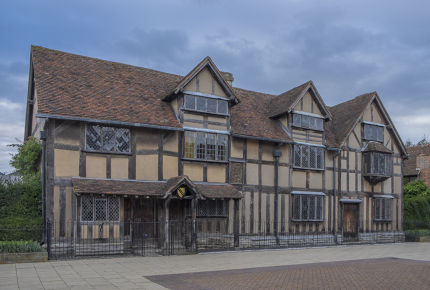 Shakespeare's restored first home is now a dedicated museum
Shakespeare's restored first home is now a dedicated museum
Creative Commons / Kommercialize
2) Jorge Luis Borges, Buenos Aires
“Nothing is built on stone; all is built on sand,” wrote Jorge Luis Borges in In Praise of Darkness. He would’ve witnessed his prophecy in Buenos Aires if he were still alive. The city is changing: his favourite coffee stops are either shut or are celebrating his life with crude waxworks, like classic Viennese coffeehouse Cafe Tortoni.
A plaque marks his family home at Serrano 2135, and adjoining another of his former houses is the Jorge Luis Borges International Foundation (visits by appointment only), which holds many of his first editions. Borges, though, was a wanderer, and the grandiose avenues of the Argentinian capital beg visitors to do just that.
What to read: Buenos Aires by Jorge Luis Borges.
Don’t miss: Borges’ favourite bookshop, La Ciudad, can still be found inside the Galería del Este.
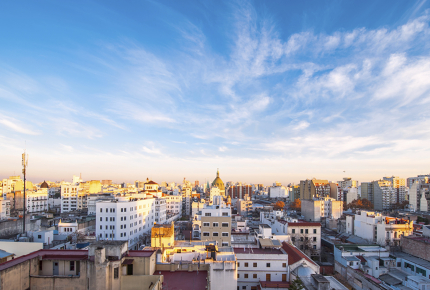 Buenos Aires has changed significantly since Borges' day
Buenos Aires has changed significantly since Borges' day
Kseniya Ragozina / Thinkstock
3) William Butler Yeats, Ireland
Rather than shroud his most treasured County Sligo spots in lyrical mystery, the great Irish wordsmith, William Butler Yeats, celebrated them in his poetry. Among the damp green hills, stacked cairns and silent holloways of Sligo, visitors can still see the Lough Gill mist lift from the small atoll that inspired The Lake Isle of Innisfree.
It’s here, in the area Keats called ‘The Land of Heart’s Desire’, that you’ll find Coole Park, which Yeats mentions in The Wild Swans at Coole and In the Seven Woods. But it’s Ben Bulben, a vast rocky brow of ancient Ireland, that overpowers most. Stand beneath its glare and read Under Ben Bulben.
What to read: The Collected Works, Vol. 1: The Poems by W. B. Yeats.
Don’t miss: Ardent fans shouldn’t leave without visiting Thoor Ballylee, the Norman tower Keats turned into a study and a summer home, which reopened in June 2015. The pear tree “broken by the storm” in The Road at My Door still stands in the garden.
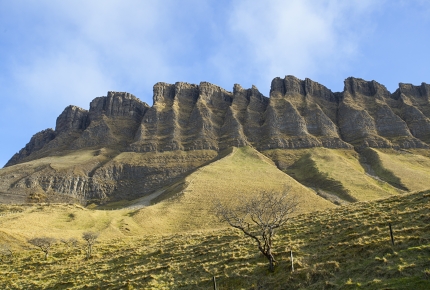 Yeats wrote about his favourite Sligo spots like Ben Bulben
Yeats wrote about his favourite Sligo spots like Ben Bulben
Marie33 / Thinkstock
4) Robert Burns, Ayrshire
From Rabbie Burn’s local howff (boozer), right down to his wooden writing desk, you can’t go far in Ayrshire without being reminded of the Scottish bard. The Robert Burns Birthplace Museum includes entry to the quaint thatched cottage where he was born in 1759 and is the best place to trigger intrigue.
For a more lyrical lilt, head to Kirkoswald and visit the cobbler's shop epitomised in Tam o' Shanter, which has several sandstone statues including Tam o' Shanter, Souter Johnnie and the poet’s innkeeper. Then move onto Ellisland Farm, near Dumfries, for some of Burns’ original work. Finish in the charming town itself where there are statues of the poet, plus his favourite pub, The Globe Inn.
What to read: The epic Tam o' Shanter by Robert Burns.
Don’t miss: For real Rabbie buffs, Burns’ favourite chair still props up the bar at The Globe Inn. However, before you hunker doon, make sure you can recite some of his poetry – else you’ll be buying the rest of the pub a beer.
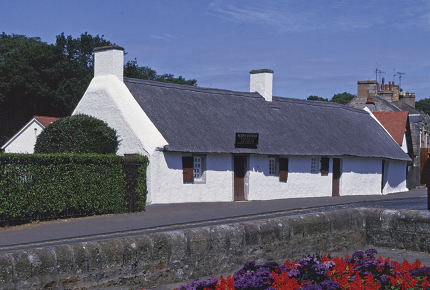 Burns' original cottage home is the star attraction in Ayrshire
Burns' original cottage home is the star attraction in Ayrshire
Derek McDougal / Thinkstock
5) Charles Baudelaire, Paris
From Balzac to Wilde, via Hemingway, Proust and Rimbaud, Paris has long enticed the world’s greatest writers – and spat many of them out too. But it was Charles Baudelaire who bared the city’s sinful secrets through Les Fleurs du Mal and Le Spleen de Paris.
That’s why the best starting point for understanding Baudelaire’s Paris is Hotel Lauzun, the rundown hovel where he smoked, shagged and shared a destructive relationship with his mistress and muse, Jeanne Duval. The liaison spawned Le Balcon and Parfum Exotique.
There is a bust of Baudelaire in Luxembourg Gardens and a cenotaph of the poet in Montparnasse Cemetery. Baudelaire’s body, however, is in the family tomb nearby, much against his will.
What to read: Les Fleurs du Mal by Charles Baudelaire.
Don’t miss: In testament to Baudelaire’s bohemian lifestyle, walk to 57 rue de Seine, where the poet once lived. So burdened with debt during his time here, he only emerged at night.
 Charles Baudelaire wrote about Paris’ sinful secrets
Charles Baudelaire wrote about Paris’ sinful secrets
Jenifoto / Thinkstock
6) Dylan Thomas, Swansea
Though Thomas’ relationship with his birthplace, the “ugly, lovely town” of Swansea, may be hard to define, the city has posthumously embraced its most famous export with open arms.
Fans of the drunken, doomed poet can trawl through the world’s largest collection of memorabilia of its kind at the Dylan Thomas Centre and even spend the night in the poet’s first home.
More authentic literary homage can be sought through walks in Cwmdonkin Park, a source of inspiration for Thomas’ earliest works, and the ambling beachside trail to Mumbles, where you can quaff a coffee at the Kardomah Coffee Shop, frequented by Thomas and his so-called "Kardomah Gang".
What to read: Portrait of the Artist as a Young Dog by Dylan Thomas.
Don’t miss: A creative hub still nurturing local talent and showcasing a selection of plays, The Dylan Thomas Theatre (formerly the Swansea Little Theatre) is where the young Thomas cut his teeth as an actor. The nearby Antelope Pub (re-opening this year) was a favourite haunt of the poet: his fondness for which led to his eventual dismissal from the theatre.
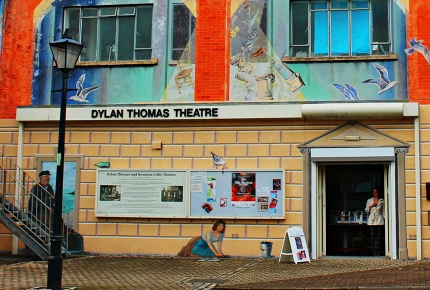 The Dylan Thomas Theatre puts on a range of performances
The Dylan Thomas Theatre puts on a range of performances
Creative Commons / Les Haines
7) Robert Graves, Mallorca
After a tumultuous adult life that began in the trenches, prolific English poet Robert Graves said goodbye to all that and sought solace on the beautiful Balearic Island of Mallorca.
The village of Deià became Graves’ long-time family home, on and off, between 1929 and his death in 1985. Provided with the peace he so desperately craved, it was here that he wrote some of his most influential works, including the novel I, Claudius. His old home, surrounded by olive buses and orange trees, is now a museum dedicated to his life.
What to read: I Wonder What It Feels Like to be Drowned? by Robert Graves.
Don’t miss: Graves’ modest headstone, guarded by a cypress tree, is visible in the churchyard a short distance from his home in Deià.
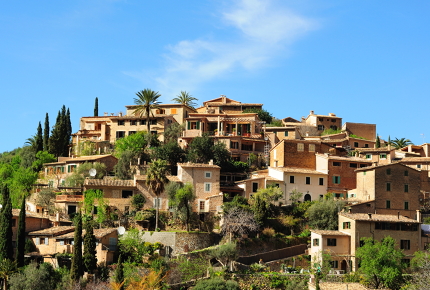 Robert Graves moved to Deià, Mallorca in 1929
Robert Graves moved to Deià, Mallorca in 1929
Wolfgang Eichentopf / Thinkstock
8) William Wordsworth, Cumbria
Wandering lonely as a cloud, William Wordsworth found inspiration through much of the Lake District, and the "host of golden daffodils; Beside the lake, beneath the trees” still dance in spring breeze on the shores of Lake Ullswater.
Bookend your pilgrimage with a visit to his fantastic Georgian birthplace in Cockermouth and a trip to St Oswald’s Church in Grasmere, where a simple gravestone marks his final resting place. Spend the rest of your time rambling through Glencoyne Park and to the stone circle in Little Salkeld, which inspired The Monument Commonly Called Long Meg.
What to read: I Wandered Lonely as a Cloud by William Wordsworth.
Don’t miss: In Grasmere, Cumbria sits Dove Cottage, where Wordsworth lived and worked from 1799 to 1808. Originally a pub, Wordsworth stumbled across the cottage when walking with fellow wordsmith, Samuel Taylor Coleridge.
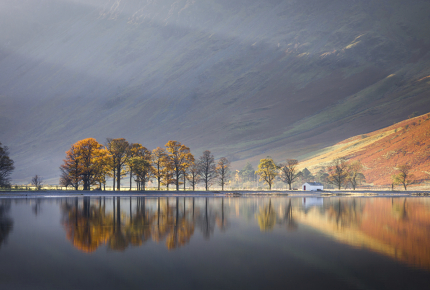 The beautiful Lake District has long been a source of inspiration
The beautiful Lake District has long been a source of inspiration
Creative Commons / Noel Bennett
9) Walt Whitman, New York
Ugly, rotten, scabbard, yet vivacious, bustling and eclectic – even in the 21st century you don’t need a scholarly local tour guide to uncover the New York setting that frequently dominates Walt Whitman’s poetry.
Little of the poet’s hangouts remain; even Pfaff’s, an infamous basement café favoured by the bohemian crowd, has become a series of shops. Similarly, the fireman’s hall, where Whitman drank with celebrated poet Ralph Waldo Emerson, has lost much of its ornamentation, though its facade remains.
Whitman revelled most in simply walking among the bundling masses – something that is hard to escape in the city today.
What to read: Give me the Splendid, Silent Sun by Walt Whitman.
Don’t miss: Away from the bustling city streets, Jayne’s Hill in the West Hills County Park was an oasis of calm for Whitman. The celebrated poet frequently walked the trail, which climbs to the highest point of Long Island. He also wrote of it often.
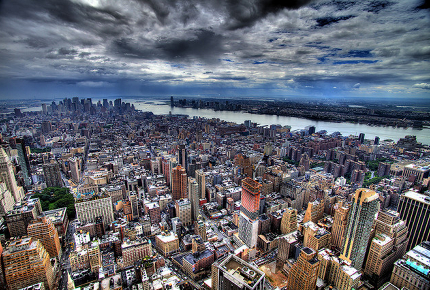 Whitman loved wandering the bustling streets of New York
Whitman loved wandering the bustling streets of New York
Creative Commons / Jakob Montrasio
10) Thomas Hardy, Dorset
While the common setting of Thomas Hardy’s works, Wessex (a forest strewn green space with a rasping coastline and thatch cottage villages), may appear too quaint to be true, it’s actually a thinly veiled Anglo-Saxon pseudonym for Dorset and its picturesque surrounds.
Following the Thomas Hardy Trail, visitors can literally walk in Hardy’s footsteps along tracks that explore the churches, homes, manors and villages visited by the poet throughout his lifetime. Many of these locations seem stuck in a time warp and offer first-hand experience of the places that inspired some of his most popular poetry.
What to read: The Children and Sir Nameless by Thomas Hardy.
Don’t miss: Head to Higher Bockhampton in Dorset to tour Hardy’s Cottage, the seemingly untouched birthplace and childhood home of this acclaimed poet. Some of his earliest works, including Under the Greenwood Tree, were written here.
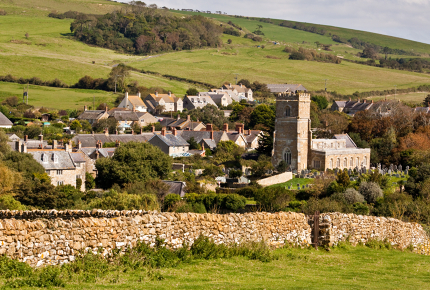 Crumbling Dorset appears unchanged since Hardy's time
Crumbling Dorset appears unchanged since Hardy's time
Martin Kemp / Thinkstock
Do you have any Feedback about this page?
© 2025 Columbus Travel Media Ltd. All rights reserved. No part of this site may be reproduced without our written permission, click here for information on Columbus Content Solutions.









 You know where
You know where